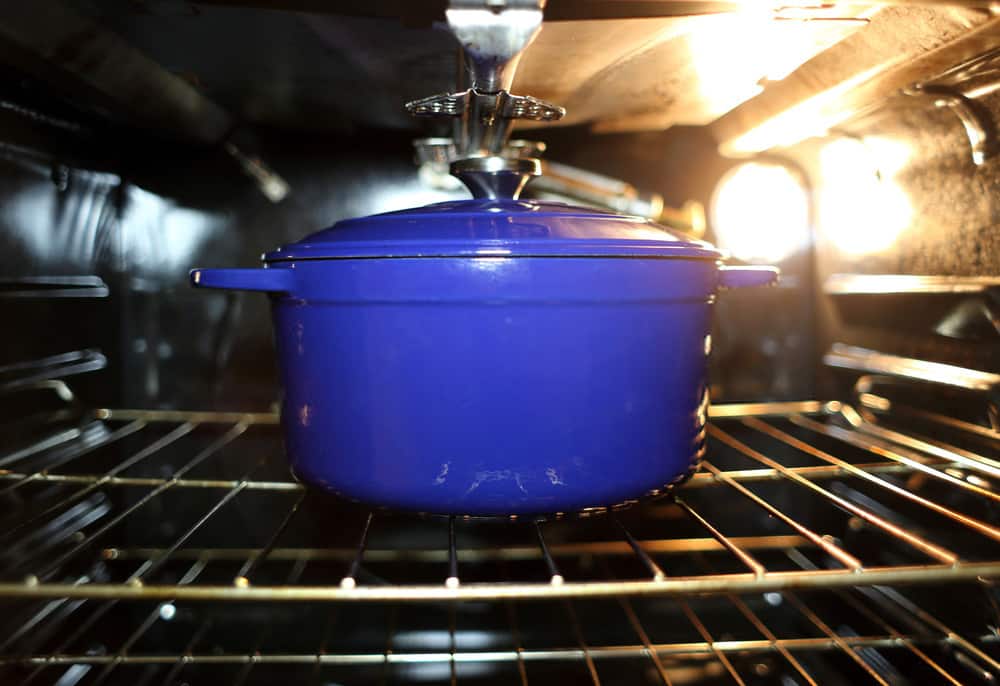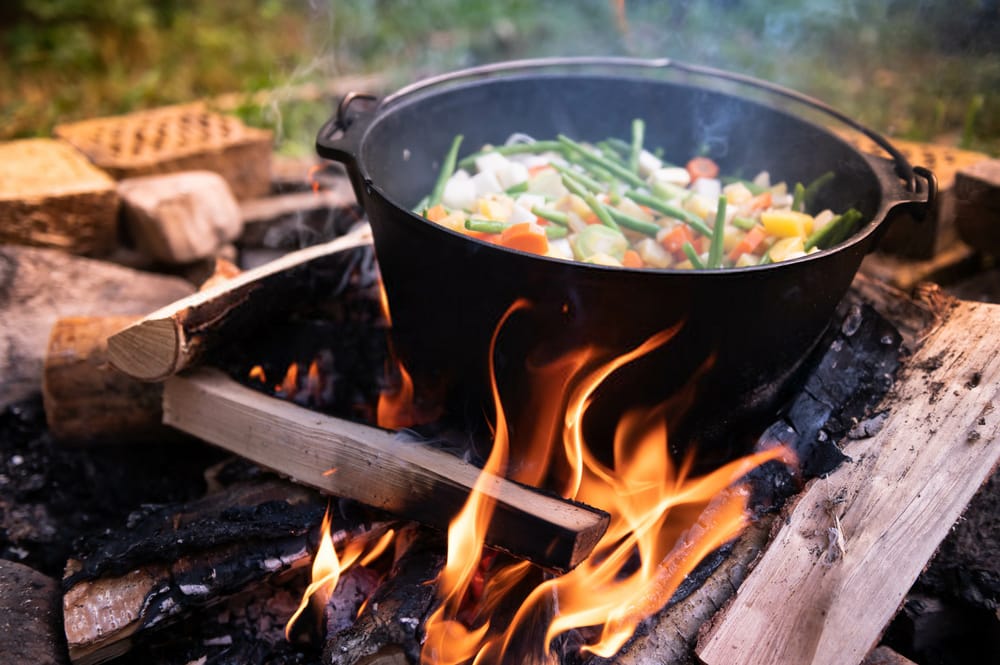Introduction
Today, we’ll be comparing two different cooking pots that are extremely popular in the kitchen, the french oven and the dutch oven. These are both types of pots that are typically made from materials like cast iron, aluminum, stainless steel, or copper.
The Dutch oven is most commonly used for braising meat recipes. The french oven is perfect for anything you need to cook low-and-slow with a thick bottom for heat distribution
Both have their pros and cons with their own benefits over one another. But which one will suit your needs better? Let’s find out…
What is a Dutch oven?

A Dutch oven is a large cooking pot used for slow cooking recipes. The standard Dutch oven can hold 8 quarts of liquid. This pot is typically round in shape with the base being wider than the top. This is what you’re probably picturing if you think of a Dutch oven already. This shape is preferred because it promotes even heat distribution which allows for slow cooking that will not burn the food at the bottom.
Dutch ovens have a flat top and a flat bottom which means you have to use a trivet or hot pad holder to protect your table from heat damage. These pots are typically used directly over a flame, grill, campfire, or gas burner. You can even place them directly on coals that have been pre-cooled for this purpose.
While dutch ovens are typically used as slow cookers often for braising recipes, they can also be used as boiling pots too. Dutch ovens are great for making large quantities of soups and stews.
Advantages of Dutch oven
The primary advantages of dutch ovens are as follows:
- They distribute heat evenly which prevents burning
- They’re heavy duty, very durable, and will last for a long time even with daily use
- They can withstand high temperatures that would damage other pots
- Their simple design makes them easy to clean and maintain
What is a French oven?
A French oven can be a pot or a casserole dish, depending on the type you get. A standard french oven will resemble the dutch oven but with a smaller volume capacity of anywhere from 2-8 quarts of liquid. A french oven will typically be wider in diameter than it is tall which allows for faster boiling when cooking recipes that require it.
It’s best to avoid using a heat source directly underneath the french oven because of its thin walls. Instead, you’ll want to use a heat diffuser to prevent damage the thin, hot walls of this pot. You can find these accessories at most home or kitchen stores so they’re readily available for purchase if you don’t already have one on hand.
When using a french oven, you would typically place it inside another pot that contains water which acts as your heat source instead. This prevents damage to the bottom of your pot while still allowing you to cook with high temperatures if needed.
This is a great pot for baking recipes because it conducts heat well and allows you to use an oven without the lid. French ovens are typically made from aluminum or cast iron, with higher end models made from ceramic, copper, or even stainless steel.
Advantages of French oven
- It conducts heat while still being able to cook food at higher temperatures.
- Can be used as a baking dish for baking recipes
- The flat bottom means you can use it directly on hot coals
- The walls are thin so it’s easy to store and easy to carry
What is the difference between French and Dutch ovens?
The major difference between these two pots is their shapes, with standard Dutch ovens being wider in diameter than tall while french ovens are taller in diameter than wide which limits their capacities based on their shapes, respectively.
Differences Between a Dutch Oven and a French Oven
Care and Maintenance
Both a Dutch oven and a French oven require a certain level of care to ensure they remain in good condition after time. A dutch oven requires you to hand wash it with mild detergent and scrub out stubborn food particles with a brush. After it’s been cleaned properly, you’ll want to dry it off as best as possible before storing it.
A french oven typically has more handcrafted details that makes it more susceptible to damage if not protected during storage and use, so you’ll definitely need some protective storage bags or covers for your pot during these times.
Durability
A Dutch oven is typically more durable than french ovens because dutch ovens are made for high temperatures and they’re made from thicker materials like cast iron, stainless steel, or aluminum.
French ovens are typically thinner and less dense than dutch ovens making them less durable over time. The walls of french ovens are typically made with ceramic, which is prone to chipping if not cared for properly. A dutch oven can last for up to 30 years while a french oven typically only lasts 10-15 years before it needs replaced.
Usage
The difference in the shapes of these two pots will affect how you can use them in your kitchen. A dutch oven is typically designed for slow cooking and simmering recipes. The wider pot allows you to fit more food into it at once and the shape of the pot promotes even heating.
Dutch ovens are perfect for braising meat because they can withstand high temperatures for a longer period of time without allowing the food to burn at the bottom.
You’re able to bake with your french oven because it’s designed with an open top which allows you to place it directly in an oven without needing a lid. A french oven is best for boiling water or making soups or stews that require large quantities of liquids.
Weight, Size, and Volume
The weight and size of these two pots can vary greatly depending on the model you choose. A dutch oven is designed to be heavier than a french oven, which is one of the reasons why it’s more durable. They’re both average sized pots that are easy to store. The volume capacity of these pots varies based on the size of the pot itself. The larger a dutch oven, the higher the capacity it can hold.
The weight of a dutch oven is typically around 8 to 10 pounds while the weight of a french oven ranges from 5 to 10 pounds. A dutch oven holds 8 quarts while a french oven offers up to 30 quarts of space.
Cooking Features
As far as cooking features, a dutch oven is great for boiling food and simmering recipes because of its thick pot walls and its large size. You can also use it for baking certain types of recipes because it’s made with an open top so you don’t need a lid for this purpose as well.
Aesthetics
A Dutch oven will typically have a plain finish because it’s designed to be a working pot used for cooking. A french oven is typically constructed with a glazed finish to add more color and character to your pot.
Price
A dutch oven is affordable and cost effective because there are many different styles to choose from that can fit anyone’s budget. A french oven is also relatively inexpensive but it may be more expensive than a dutch oven depending on the brand and style you choose.
Which One Should You Buy?
If you’re looking for a versatile pot that can last a long time, a dutch oven is probably going to be your best choice. They’re typically less expensive, they’re sturdier and more durable, and they can be used in a number of different ways in your kitchen.
A french oven is great if you’re looking for a pot that’s easy to store or transport because it’s lightweight. Plus, the shape of the pot will allow you to take advantage of a variety of different recipes while still using a single pot for everything. If you already have a dutch oven on hand and you want to add another pot to your collection, a french oven is going to be able to offer you an entirely different set of benefits than what your dutch oven has provided you with before.
Is a French oven the same as a Dutch oven?
There are a lot of different variations, but a Dutch oven is a pot designed to be used on a stove while a French oven is typically used over an open flame.
The only real differences between the two are their shapes and sizes. The gourmet chefs that make these pots understand how to use them, so the price you’ll pay over time will vary over time as well.
Why should I get a French oven?
Food tastes better when it’s been cooked slowly in an oven. That’s because the food has been able to absorb more of the flavors from the food itself, not from any secret spices or seasonings that went into it.
What do you cook in a French oven?
There are many recipes that call for a French oven. Some of the recipes included in this category include soups, stews, casseroles, and a variety of different desserts that call for a delicate touch when cooking.

